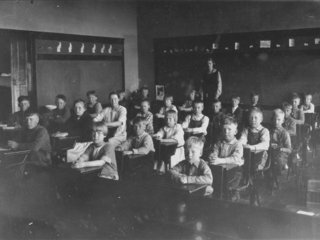Resetting education: the shift to digital textbooks
There's a world of potential in interactive e-textbooks, but how can schools afford it?
Read more...
Education technology has come a long way over the last decade. The solutions and products being developed today are taking education closer than ever to completely individualized instruction, addressing the needs of each student rather than teaching to the majority of the class and ignoring those that struggle.
“Education is increasingly about ‘personalized’ learning—but figuring out what that means is a billion dollar question,” said Betsy Corcoran, founder of EdSurge, an online information treasure trove for all things edtech. “Does it mean you study only things that are interesting to you? Does it mean that an algorithm tries to calculate how you most quickly absorb facts or ideas and tries to present information that way to you? We're just at the beginning of figuring out what ‘personalization’ is all about—and the myriad of ways technology can help deliver that.”
From companies like Knewton and Khan Academy to Goalbook and ExitTicket, schools and startups are finding innovative new ways to reach each individual student, but how are schools putting technology to use? Specifically, how are they utilizing new technology under budgets that are already cash-strapped? It’s a question that was raised in the very beginning of the series, and different companies have found ways to scale, whether it’s by appealing directly to teachers, or by working with state and federal programs that subsidize costs for schools.
The cash crisis
Money is a very real issue that can’t be overlooked when you’re talking about edtech. Take the flipped classroom model, for example. Having students watch lessons online at home, or log into an educational social network after school is a great idea—but what about those kids who don’t have Internet access at home? Sure, most families do, and those students who don’t can probably access the material from a family member’s smartphone, but why put the onus on the student to have to work that much harder just to keep up with his more well-off classmates?
And what about low-income schools that are already working with less and trying to stretch each dollar so that they can afford the basics?
In California—one of the hardest hit economies in the recession, education accounts for 50% of the state budget. A November ballot initiative proposed by Governor Jerry Brown, if passed, is expected to raise $8.5 billion in the next fiscal year by raising sales tax by a quarter of one cent to 7.5% for the next four years, while also raising income taxes on individuals earning more than $250,000 a year for seven consecutive years. If the tax initiative is not passed in November when voters take to the polls, $6 billion in automatic cuts will go into effect—and public schools and universities will suffer the bulk of those cuts.
But some California schools are finding interesting ways to retool their budgets so that they can utilize emerging education technologies without having to raise extra money. Rocketship Education, a network of charter schools in San Jose, has found a way to use technology to cut down on costs while  individualizing learning for each of its 3,700 mostly low-income students, and paying teachers 1.2X what they would normally make in a traditional public school.
individualizing learning for each of its 3,700 mostly low-income students, and paying teachers 1.2X what they would normally make in a traditional public school.
And the schools are getting pretty impressive results. Rocketship schools, which currently consist of seven campuses throughout San Jose, are the top performing schools in the state serving predominantly low-income students and outperform many school districts in more affluent neighborhoods. Some 90% of students entering Rocketship schools in the bottom two quintiles of achievement move up to the basic level or above within one year. Additionally, Rocketship aims for 1.5 years of academic growth per year in literacy and math.
What’s the secret formula?
The best way to understand how Rocketship works is to compare it to traditional public schools. Rocketship is an elementary school system, but it operates more like a middle school where students move from one class to another to study individual subjects with specialized teachers. In a typical middle school, a student might see four teachers a day—perhaps a math teacher, a language arts teacher, a social studies teacher, and a science teacher. In a Rocketship school, that same student might see three of those teachers, and spend the fourth period in Learning Lab.
Students go to Learning Lab every day for an hour and 40 minutes. There, they spend one-on-one time on computers, working with adaptive learning programs in math and literacy. In essence, Learning Lab takes over the lower-level tasks that consume so much of teachers’ days—things like quizzes, assessments, and remediation. Programs include DreamBox Learning, TenMarks, ST Math, Equatia, Compass Learning, Accelerated Reader, and even Rosetta Stone for English language learners.
In a traditional classroom, if a teacher wants to figure out where each student is on a topic, he or she might administer a paper quiz, which means carving out class time for the quiz itself, and then going through and grading each one to see what students are doing. In Rocketship schools, such quizzes are handled in Learning Lab, where grading and assessment is automated so teachers can instantly see where their students are and focus on higher-order tasks, like engaging with the subject material in a class discussion or a group project.
Or, perhaps a first-grade classroom is working on double-digit addition, but one student hasn’t figured out how to carry a number. Rather than taking up valuable class time to teach to one student’s needs, the teacher can have that student catch up in Learning Lab.
In some ways, it’s like flipping the classroom—in the classroom.
Cost savings
The setup actually allows Rocketship to higher fewer teachers, which, in turn, allows them to invest more of their resources into the teachers that they do hire. The cost savings are huge. Each individual Rocketship school saves $500,000 a year. As a result, Rocketship can afford to hire the best teachers (most come straight out of Teach For America, so they’ve already been stringently vetted), pay them more than the average teacher earns, and allow them more time for actual teaching.
This naturally leads to better job satisfaction for teachers. Teach turnover is a major problem. Some 50% of new public school teachers will quit in the first five years. The majority of those who quit in their first five years identify an unmanageable workload and too little time in the day to get everything done as one of their primary reasons for leaving. Rocketship, however, boasts a much higher retention rate, with four out of five teachers returning the next year since 2008-09.
But Learning Lab isn’t all about time and cost savings. Research into the efficacy of the school’s model has found that Rocketship students who received additional math instruction through the DreamBox Learning Program over the course of 16 weeks scored an average of 2.3 points higher on the Northwest Evaluation Association’s mathematics test than similar students who didn’t receive the instruction. For the average student, this would translate to an increase of 5.5 points in percentile ranking (such as going from the 50th percentile to 55.5 percentile) in just four months.
Replacing teachers or supporting teachers?
This doesn’t mean technology can take the place of teachers, or that schools can simply plop students down in front of computers to improve grades. Rather, technology is bringing prestige back to teaching at a time when teachers have become synonymous with daycare workers and babysitters. Having more time to teach means teachers can deliver the results parents and communities want to see, which means they can be elevated to the same social status as doctors, lawyers, and university professors.
The most effective edtech solutions are not those that try to assume the role of teacher, but those that help the teacher teach. Every one of the companies profiled in the Resetting Education series does that in some way, whether it’s automating assessment and remediation, making sure each student participates in class, or offers a fun, creative way for students to work on character building.
Rocketship may be leading the way to a future where we don’t simply have more teachers, but better, higher-paid, and more satisfied teachers.
Image source: bbps.school.nz
There's a world of potential in interactive e-textbooks, but how can schools afford it?
Read more...Gamestar Mechanic proves that educational games are more than just a nice idea
Read more...How teachers are using technology to simplify behavior management
Read more...







